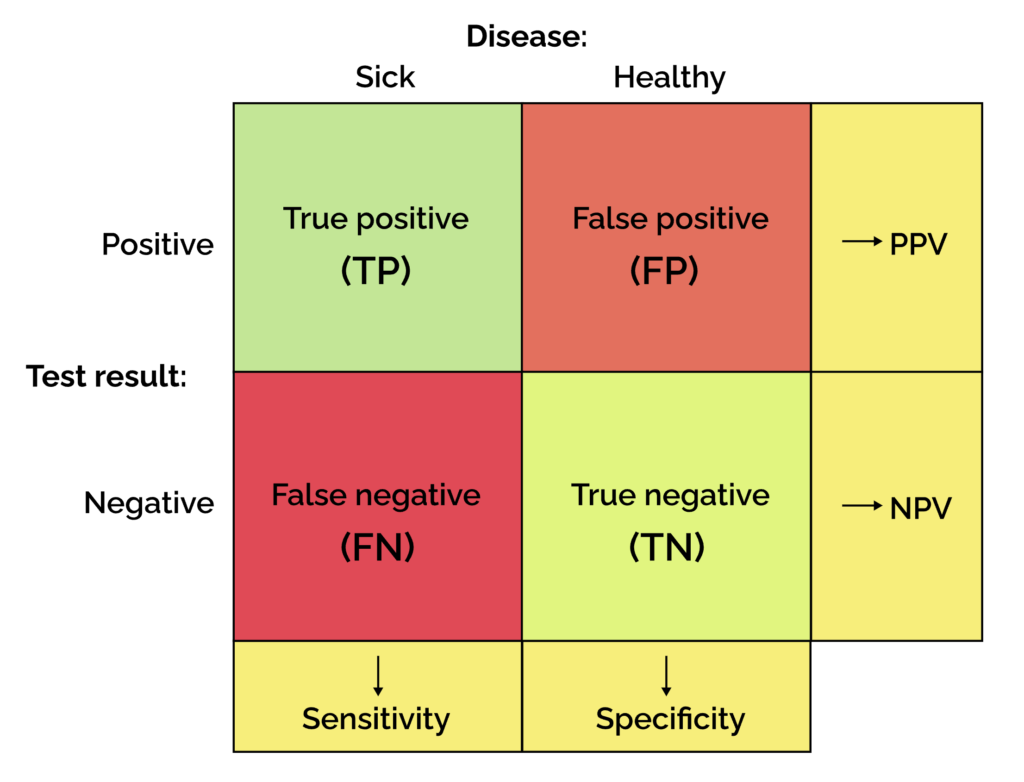Sensitivity, specificity, Positive Predictive Value (PPV), and Negative Predictive Value (NPV) are key measures used in evaluating the performance of a diagnostic test. Each metric provides different information about the test’s accuracy and utility:
- Sensitivity:
- This measures the test’s ability to correctly identify those with the disease (true positives).
- It is the proportion of actual positives (people with the disease) that are correctly identified by the test.
- High sensitivity is particularly important in tests used for early detection, where missing a diagnosis (false negatives) can have serious consequences.
- Sensitivity = True Positives / (True Positives + False Negatives)
- Specificity:
- This measures the test’s ability to correctly identify those without the disease (true negatives).
- It is the proportion of actual negatives (people without the disease) that are correctly identified by the test.
- High specificity is crucial in tests where a false positive result could lead to unnecessary further testing or treatment.
- Specificity = True Negatives / (True Negatives + False Positives)
- Positive Predictive Value (PPV):
- This measures the proportion of positive test results that are true positives.
- It indicates the likelihood that a person with a positive test result actually has the disease.
- PPV is influenced by the prevalence of the disease in the population being tested – higher prevalence increases PPV.
- PPV = True Positives / (True Positives + False Positives)
- Negative Predictive Value (NPV):
- This measures the proportion of negative test results that are true negatives.
- It indicates the likelihood that a person with a negative test result does not have the disease.
- Like PPV, NPV is also affected by disease prevalence – higher prevalence decreases NPV.
- NPV = True Negatives / (True Negatives + False Negatives)
Each value is useful in different scenarios:
- Sensitivity is most useful when ruling out a disease is crucial. A highly sensitive test, when negative, can effectively rule out the disease (e.g., HIV testing).
- Specificity is most useful when confirming a disease. A highly specific test, when positive, strongly suggests the presence of the disease (e.g., biopsy for cancer).
- PPV is the probability that a person who has a positive test result actually has the disease.
- NPV A high NPV means that a negative test result is a strong indicator that the patient does not have the disease. This can provide significant reassurance to both the patient and the clinician, especially in the context of screening for serious conditions.
In summary, sensitivity and specificity are intrinsic properties of the test itself, independent of disease prevalence, while PPV and NPV vary depending on the prevalence of the disease in the population being tested.

Sensitivity, specificity, positive predictive value (PPV), and negative predictive value (NPV) are statistical measures used to evaluate the performance of a diagnostic test. Understanding these concepts is crucial for interpreting test results, especially when considering whether a patient definitely has or does not have a disease.
- Certainty That a Patient Has a Disease
- Sensitivity: This is the ability of a test to correctly identify those with the disease (true positives). A test with high sensitivity is less likely to miss a case of the disease (low false negatives). In clinical practice, if you want to be certain that a patient has a disease, you need a test with high sensitivity.
- PPV: Positive Predictive Value reflects the likelihood that a positive test result correctly identifies the presence of a disease. High PPV means that when the test is positive, there’s a high probability that the patient actually has the disease. PPV is influenced by the prevalence of the disease in the population.
- Certainty That a Patient Does Not Have a Disease
- Specificity: This is the ability of a test to correctly identify those without the disease (true negatives). A test with high specificity is less likely to give a false positive result. In clinical settings, if you want to be certain that a patient does not have a disease, you would rely on a test with high specificity.
- NPV: Negative Predictive Value is the probability that a negative test result correctly indicates the absence of a disease. A high NPV means that when the test is negative, it’s very likely that the patient does not have the disease. Like PPV, NPV also varies with the disease’s prevalence.
- Example for Contextual Understanding
- Let’s consider a hypothetical disease and a test to detect it:
- High Sensitivity: If the test has 95% sensitivity, it means that out of 100 patients who have the disease, 95 will test positive (true positives), and 5 will test negative (false negatives). This test is reliable for ruling in the disease.
- High Specificity: If the test has 95% specificity, it means that out of 100 people who do not have the disease, 95 will correctly test negative (true negatives), and 5 will incorrectly test positive (false positives). This test is reliable for ruling out the disease.
- Clinical Implications
- A test with high sensitivity is typically used for screening purposes, especially for serious conditions where missing a case could be harmful.
- A test with high specificity is often used as a confirmatory test after a positive screening test to rule out false positives.
- PPV and NPV are particularly important in understanding the real-world implications of test results, as they consider the prevalence of the disease in the population being tested.
In summary, for certainty that a patient has a disease, focus on high sensitivity and PPV. For certainty that a patient does not have a disease, prioritize high specificity and NPV.
